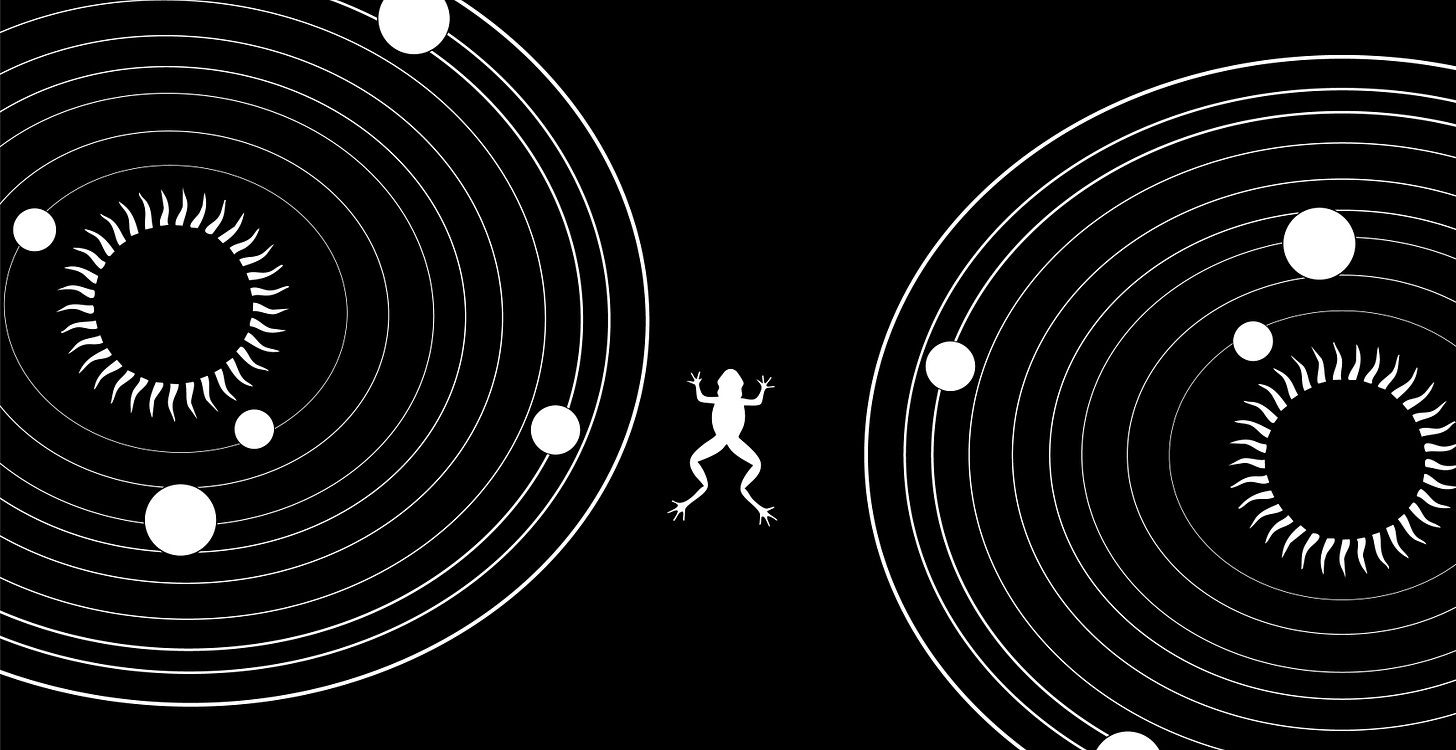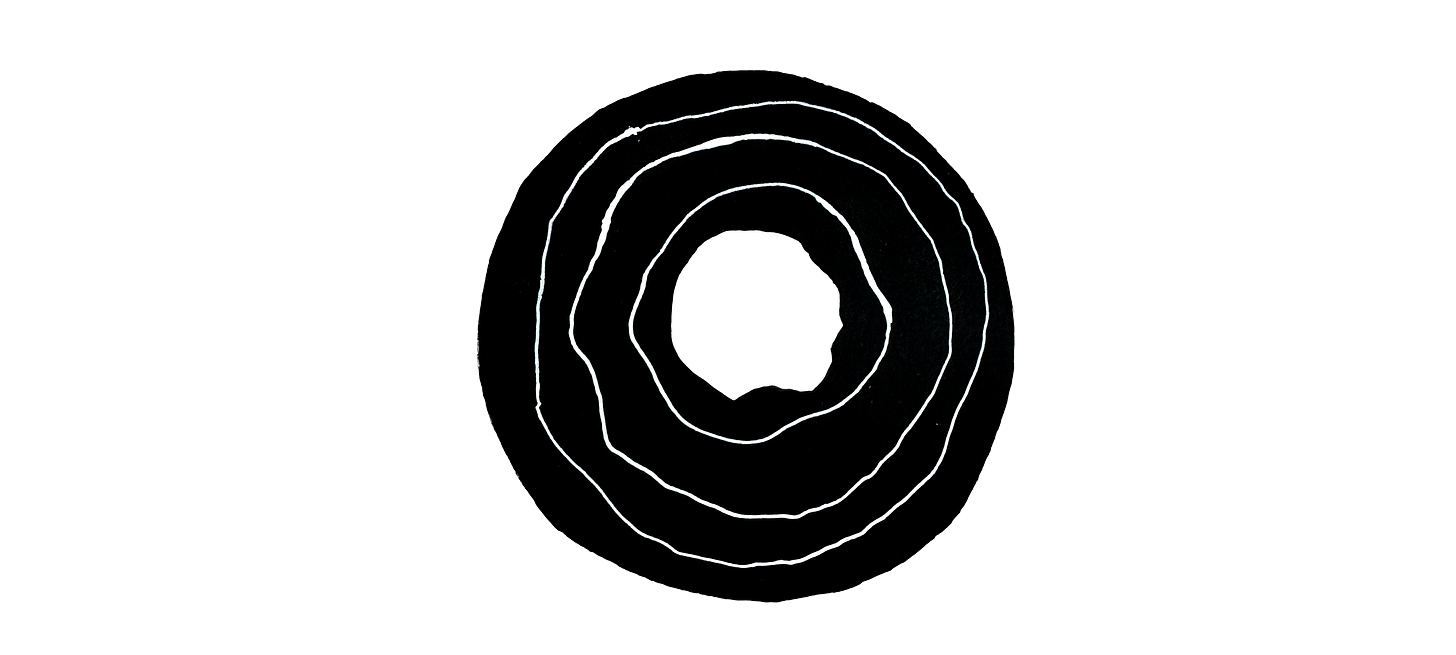As we steadily move towards the planet Dudh, now might be the perfect time to learn about the calendar of Fistbump the Sky and how it affects the weather.
In case you didn’t know, Fistbump the Sky is not a planet made from rocks, but a cake made from baking ingredients and seeds, strapped to the Great Frog’s back. As such, it does not spin on its own axis but moves as its creator does–through the universe, visiting friends and various solar systems. This, of course, made it difficult to find a constant with which to determine time, as Fistbump the Sky is never in a fixed location.
Thankfully, Interstellan Astrologers realised that they could use the three suns as a measurement of time by observing the order in which they appear. The combination Pink - Blue - Green indicates that the Great Frog is moving forward while Green - Blue - Pink indicates that he has turned around. Thus, the three suns became the indicators of the completion of a time cycle, much like how a year on Urth has a beginning and an end.
Dividing one cycle into set, repeatable periods was not only impossible but also illogical. Instead, cycles were split into the number of planets the Great Frog crossed before returning to the pink sun. A planet's time was then chopped into “days” that began once the sun(s) lit the sky and “nights” for the periods when the sun(s) were dormant. Days and nights were in turn divided into smaller periods called “breathers”, with one breather consisting of five "breaths". A breath for each of the gods.
This peculiar time measurement is possible thanks to sheer luck and the invention of the Self-Sufficient Calendars.
SELF-SUFFICIENT CALENDARS
The astronomers of Interstellar discovered that they could carve crystal blocks from star-infused sand. They used these blocks to share everything the stars observed with their world’s creatures. This information was organised based on which suns are close to Fistbump the Sky, how long they were near a new planet, and the related weather changes. To ensure accuracy, the astronomers fused a piece of one of the Great Frog’s eyelashes that they had found years ago, that aided the astronomers in determining their location in the vast universe.
Many consider these calendars one of Fistbump the Sky’s greatest technological marvels, and rightfully so. Those who wish to learn more about the calendars and any other technological innovations can do so by reading the fourth chapter of The Fantastical Encyclopedia of the Imagined World of Fistbump the Sky.
The following is the expected calendar of the current time cycle of Fistbump the Sky…
THE THREE SUNS
According to the current combination of Pink - Blue - Green suns, we will again be moving forward in space during this current time cycle and can expect to encounter a new planet when all three are shining in the sky. Fortunately for us, the sun's heat is evenly distributed, reducing the chances of being burned to a crisp since the pink sun is the only true source of light and heat. The blue sun, as you might recall, only warms plant life, and the green sun only produces light.
You can expect mild weather during this time, but please make sure to protect your eyes as we near the stage of all three suns.
PLANET URTH
The first planet we can expect to pass is Urth. According to its inhabitants, Urth consists of rock covered in large masses of water. It spins on a tilted axis and rotates by the force of love or money, depending on who you ask. The Great Frog should take approximately ten days to pass the planet.
We can expect comfortable weather during these ten days. Please remember to secure yourself and any important belongings during Urth time to counter its gravitational force.
PLANET SPOT
We project to leave Urth’s solar system and meet the second planet once we enter the Simplicity Galaxy. We have yet to come into contact with any life forms, intelligent or not, on this planet. Until we do, this planet will be referred to as planet Spot after its only recognisable feature.
Thankfully, it has less gravitational force than Urth. Light spot rains can be expected during this time which will consist of fifty days.
PLANET JUPE
The Great Frog will continue his journey through the Simplicity Galaxy, making planet Jupe the third planet we will encounter. Jupe’s centre is believed to be destructive lava that is sealed in a thick layer of jelly-like substance. Jupe could be our neighbour for either fifteen days or thirty, depending on whether the Great Frog remembers our plea to be as far away from Jupe as possible.
Please refrain from going outside during the night. As we know, Jupe's peculiar jelly-like surface tends to interfere with our biological structures, turning unsuspecting creatures into goop.
PLANET DUDH
The milk planet will be our next galactic neighbour for about sixty days. Creatures planning to explore Dudh should remember not to bring any part of the milk planet to Fistbump the Sky. This will help avoid the water pollution we experienced last time. Frigid temperatures can be expected along with a faint scent of cheese in the air.
PLANETS YIN & YANG
As we leave the Simplicity Galaxy, there is a high chance that we will be making our way between the twin planets, Yin and Yang.
This will be our first time coming into contact with both simultaneously. As there is still no way of knowing whether one planet will cancel out the effects of its twin, we must consider the possibility of experiencing the effects of both. As such, all creatures are ordered to reach higher ground in case of floods. Please keep a watchful eye on any emotional fluctuations in yourself and loved ones during the five days we will share with planets Yin and Yang.
PLANET BLOOM
The last planet we can expect as we near the end of the cycle is planet Bloom. A true blessing, creatures can expect the usual enhanced plant growth during the forty days we will be moving next to the benign planet. To avoid embarrassing disasters, creatures prone to frequent baths are politely reminded to dry themselves thoroughly to prevent moss or other growth covering their bodies. Sadly, we have still not detected any life forms on planet Bloom, but we remain hopeful because how can a planet that enhances life not have its own?
THE DARK TIME
Once we leave planet Bloom, we will immediately enter the DARK TIME. As you know, Fistbump the Sky will be alone during this period when the Great Frog makes his holy return to the three suns. Without other planets or suns, we can expect deadly cold temperatures and a rise in insanity. We are still uncertain of the exact number of days this will last, but don’t give up.
The Dark Time is temporary, and we will see the three suns again soon. Despite the emptiness that will be surrounding us, we will not be alone. We have asked the leader of Interstellar if a negotiation can be made with some of the stronger stars to accompany us until we once again reach the suns.
Thank you for reading the calendar. May it help you prepare accordingly.
Written and Illustrated by Louie Smit

















Your blend of whimsy and meticulous logic (star-sand calendars, sentient jelly planets) creates that rare kind of fantasy that feels both wildly original and strangely believable.
Beautiful article and illustrations as always. Thank you Louie
An astonishing amount of creativity and thought. Epic as ever 💪